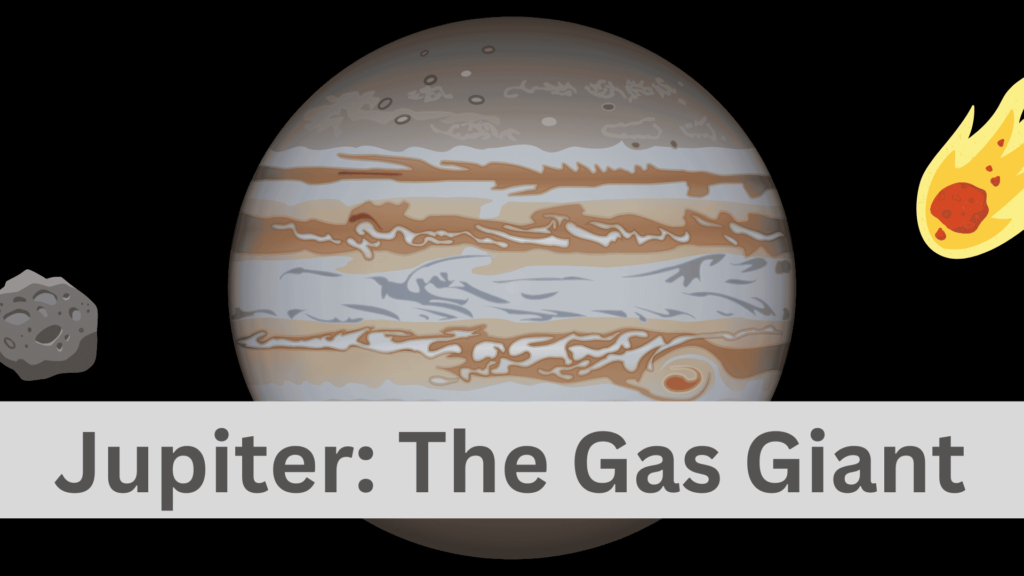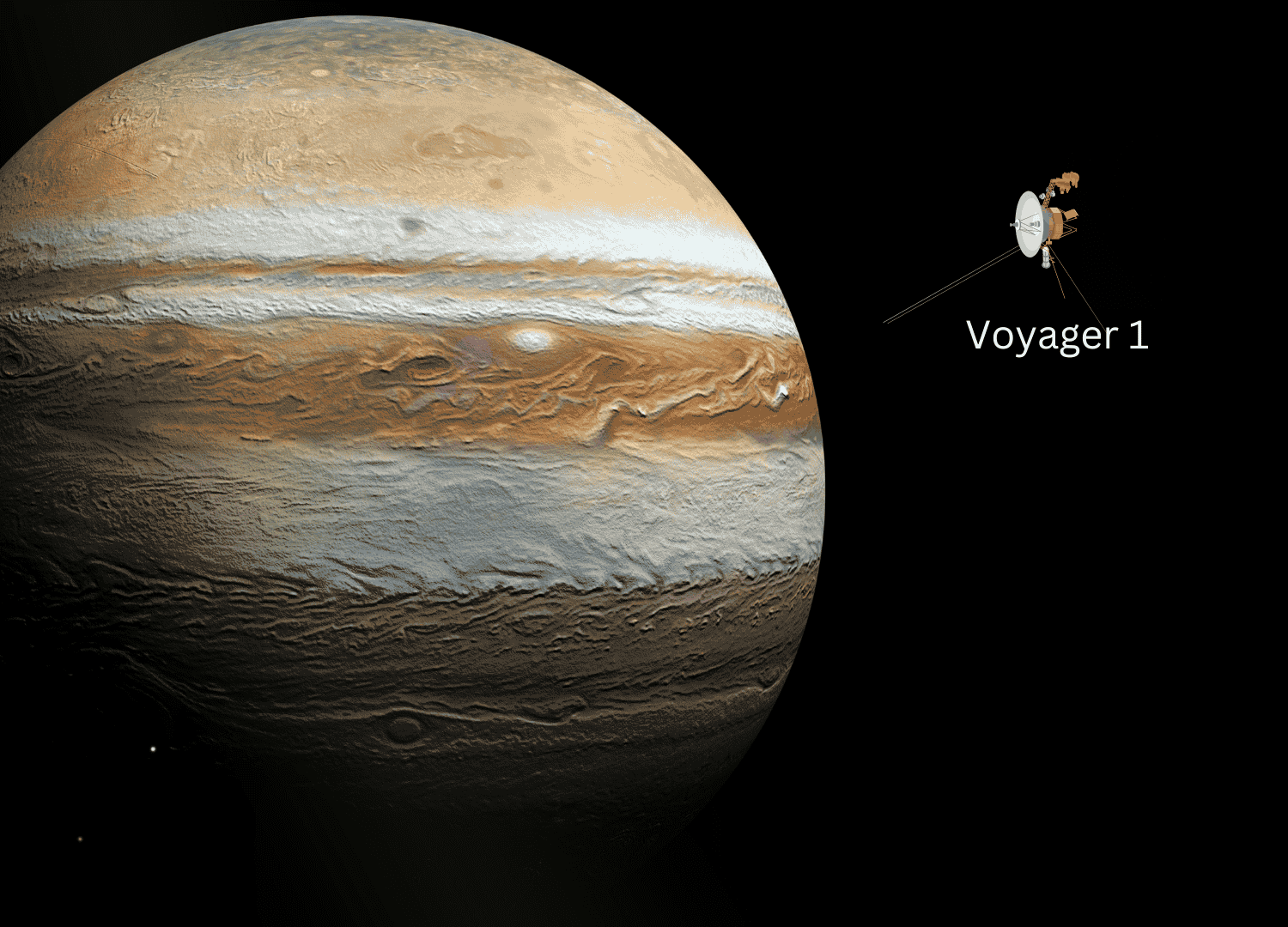

Jupiter, the largest planet in our solar system, has fascinated astronomers and scientists for decades. This gas giant is unique not only in size, but also in composition, atmosphere, and number of moons. In this post, we’ll look at all Jupiter has to offer, from its tremendous storms to its enticing moons, making it your one-stop shop for learning about the king of planets.
Size and Composition
Jupiter is the fifth planet from the Sun and by far the biggest. It has a diameter of approximately 142,984 km, which is more than 11 times larger than Earth. Jupiter’s sheer vastness allows for more than 1,300 Earths to fit inside. Despite its massive size, Jupiter, like the Sun, is essentially made up of hydrogen and helium. It is classified as a gas giant, along with Saturn, Uranus, and Neptune, because it lacks a solid surface and is primarily gaseous.
Atmosphere and Weather Pattern
Jupiter’s atmosphere is active and turbulent. Its highest layers are formed up of dense clouds largely of ammonia and water, which appear as alternating bands of light and dark colors. These bands are caused by the planet’s powerful winds, which can reach speeds of up to 400 mph (640 km/h).
One of Jupiter’s most remarkable atmospheric characteristics is the Great Red Spot, a massive storm that has been raging for at least 400 years. This storm is so massive that it might swallow Earth entirely. Jupiter also suffers numerous storms, many of which are more intense but shorter-lived than the Great Red Spot.
Magnetic Field
Jupiter has the greatest magnetic field in the solar system, almost 20,000 times greater than Earth’s. This massive magnetic field is caused by Jupiter’s fast rotation (a full rotation takes just under 10 hours) and its liquid metallic hydrogen interior. This tremendous magnetic field creates massive radiation belts, making the area around the planet highly dangerous for spacecraft.
Moons of Jupiter
Jupiter possesses an incredible 92 moons, the most renowned of which are the Galilean moons: Io, Europa, Ganymede, and Callisto, named after their discoverer Galileo Galilei in 1610. These moons are not only huge, but also have unique features:
Io: The most volcanically active body in the solar system, with hundreds of active volcanoes.
Europa: It’s considered one of the most promising candidates for finding extraterrestrial life due to the subsurface ocean that is believed to exist beneath its icy crust.
Ganymede: The largest moon in solar system even bigger than the planet mercury. Ganymede is the only moon known to have its magnetic field.
Callisto: One of the most heavily cratered object in the solar system, It’s believed to have an ancient surface.
Jupiter’s Rings
Jupiter has a weak ring system, which is primarily made up of dust particles ejected by its moons. Jupiter’s rings, discovered by the Voyager 1 spacecraft in 1979, are made up of three primary components: the halo ring, the main ring, and the gossamer rings. In contrast to Saturn’s ice rings, these rings are mostly composed of tiny particles.
Jupiter’s Role in the Solar System
Jupiter’s huge size and gravitational force have had a tremendous impact on our solar system. It functions as a cosmic vacuum cleaner, collecting or ejecting comets, asteroids, and other material that would otherwise collide with the inner planets, including Earth. Some hypotheses propose that Jupiter’s gravity shaped the early solar system by preventing planet formation in the asteroid belt, leaving only smaller objects left.
Space Missions to Jupiter
Several space missions have been launched to examine Jupiter and its moons. Pioneer 10 was the first spacecraft to sail past Jupiter in 1973, followed by Pioneer 11, Voyagers 1 and 2, and the Galileo orbiter. The most current mission, Juno, has been orbiting Jupiter since 2016, gathering extensive information about the planet’s atmosphere, magnetic field, and internal structure. NASA also has plans to explore Jupiter’s moon Europa through the Europa Clipper mission, which is scheduled to launch in the 2030s.
Jupiter’s Mysteries
Despite decades of research, many questions regarding Jupiter remain unanswered. One of the most perplexing questions is the depth of the Great Red Spot—scientists still don’t know how deep this storm is or why it has lasted so long. Furthermore, the exact nature of Jupiter’s core remains a source of contention. Some hypotheses claim that it contains a small, rocky core, while others believe it is more diffuse or possibly non-existent.
Jupiter in Mythology
Jupiter was the ruler of the gods in Roman mythology, presiding over both the sky and the earth. His Greek counterpart is Zeus, the god of thunder. This relationship with power and authority reflects Jupiter’s position as the solar system’s largest and most massive planet.
Conclusion
Jupiter is more than simply a large planet; it is a dynamic, ever-changing globe teeming with storms, tremendous magnetic fields, and numerous moons. Its importance to our solar system cannot be overstated, from safeguarding Earth from asteroids to providing clues about planetary formation. With ongoing missions like Juno and future expeditions planned, our understanding of Jupiter will continue to expand, revealing much more about this magnificent planet.
Understanding Jupiter provides not just insights into the solar system’s past, but also the possibility of future discoveries, particularly in the quest for life on its frozen moons such as Europa.



